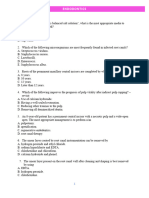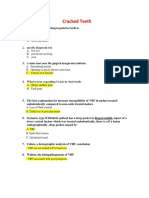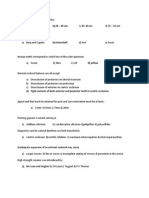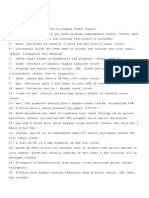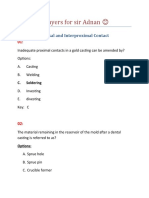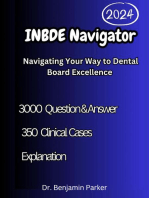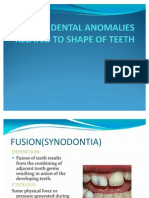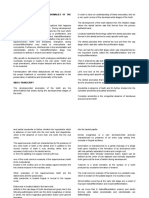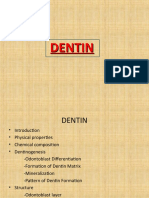Dental Anomalies MCQ
Dental Anomalies MCQ
Uploaded by
Khalid AthamnehCopyright:
Available Formats
Dental Anomalies MCQ
Dental Anomalies MCQ
Uploaded by
Khalid AthamnehCopyright
Available Formats
Share this document
Did you find this document useful?
Is this content inappropriate?
Copyright:
Available Formats
Dental Anomalies MCQ
Dental Anomalies MCQ
Uploaded by
Khalid AthamnehCopyright:
Available Formats
1. Fusion is a dental anomaly that affects the shape of the tooth and is characterized by: a.
division of single tooth germ b. having single root and root canal c. not necessarily involving dentin d. reducing number of teeth 2. a. b. c. d. e. f. g. h. Gemination is characterized by: normal number of teeth in the arch union of two adjacent tooth buds presence of single root and root canal presence of two identical separated teeth a&c a&b b&d c&d
3. Which of the following anomalies does not affect the shape of the tooth: a. Congenital syphilis b. Talon cusp c. Gemination d. Concrescence 4. a. b. c. d. e. 5. a. b. c. d. e. f. g. h. Enlargement of the tooth body on the expense of its root is called: Macrodontia Fusion Taurodontism Germination All of the above Dentinogenesis Imperfecta is characterized by: Hypoplasia of dentin with normal enamel Hypoplasia of enamel and dentin Hypoplasia of dentin and enamel with normal pulp Bulbous crown with short root and obliteration of pulp space a&d b&d a&c c&d
6. Fusion most commonly affects the following sites: a. Mandibular posterior region
b. Maxillary anterior region c. Mandibular anterior region d. Maxillary posterior region 7. a. b. c. d. e. 8. a. b. c. d. Enamel hypoplasia Is radiopaque Can not be demonstrated on a radiograph Can be demonstrated on a radiograph Is osteosclerosis None of the above Which of the following is not true about supernumerary teeth: It can prevent eruption of natural teeth If erupting, they may result in crowding It can not be detected on dental radiographs It can cause displacement of adjacent teeth
9. Radiographic diagnosis of an upper incisor consisting of two crowns and one root with one root canal: a. Fusion b. Gemination c. Supernumerary tooth d. Odontoma e. Concrescence 10.Supernumerary teeth occur radiographically: a. In mandible only b. In permanent teeth only c. In deciduous and permanent teeth d. In deciduous teeth only e. None of the above 11. An intra oral radiograph revealing absence of normal radiopacity of enamel, decrease in size and changes in shape of teeth is most likely presenting a case of: a. Turners hypoplasia b. Amelogenesis imperfecta c. Congenital syphilis d. Dentinogenesis imperfecta 12. Panoramic radiographs of a young adult showed permanent teeth were all short with partial or total obliteration of pulp chambers and root canals. The most likely diagnosis is:
a. b. c. d.
Dentinogenesis imperfecta Infantile cortical hyperostosis Cleido cranial dysplasia Craniofacial dystosis
13. An intra oral Periapical radiograph of a maxillary second bicuspid demonstrates a sharp right angle deviation of the apical third of the root. The most likely diagnosis is: a. Fusion b. Dilacerations c. Dense in dente d. Taurodontism 14. Hutchinsons teeth in congenital syphilis are types of: a. Abnormality in structure b. Abnormality in number c. Abnormality in shape d. Abnormality in size e. a, b & c f. a, c & d g. b, c & d h. c & d 15. Dentinogenesis imperfecta is characterized by: a. Marked hypoplasia and hypocalcification of dentin b. Normal enamel c. Thin cementum d. Totally obliterated pulp chamber e. a, b & c f. a, c & d g. a & c h. a & d 16. Gemination is characterized: a. Normal number of teeth in arch b. Union involving enamel, dentin and cementum c. Teeth have individual root canals d. Teeth have single root and root canals e. a, b & d f. a, b & c g. b & c h. b & d
17. Fusion of teeth: a. results from division of single enamel organ b. results in a tooth with single root and root canal c. does not necessarily involve the dentin d. could cause reduced number of teeth
18.Microdontia most commonly affects: a. Upper lateral incisors b. Upper canine c. Upper central incisors d. Upper premolars 19. In Amelogenesis Imperfecta, the affected teeth appear: a. Undersized radiographically with thin enamel and normal contour b. Normal size radiographically and normal contour c. Undersized radiographically with thin enamel and abnormal contour d. Normal size radiographically and abnormal contour 20. Dentinogenesis Imperfecta is characterized by: a. Hypoplasia of enamel of all teeth b. Hypoplasia of dentin with loss of normal enamel around most of teeth c. Normal dentin and cementum d. Bulbous crown with sort root e. a & d f. b & d g. a & c h. c & d 21. Radiograph of a young adult show that all permanent tooth roots are short and blunted with partial or total obliteration of the pulp chambers and root canals. The likely diagnosis is: a. Dentinogenesis imperfecta b. Infantile cortical hyperostosis c. Chondrodystrophica fetalis d. Cleidocranial dysplasia e. Craniofacial dystosis
22. An intraoral Periapical radiograph of a maxillary second bicuspid demonstrates a sharp right angle deviation of the apical third of the root. The most likely diagnosis is: a. Fusion b. Dilacerations c. Dens in dente d. Taurodontism
1. D 2. E 3. D 4. C 5. E 6. C 7. C 8. C 9. B 10. 11.C 12. 13. 14. 15. 16. 17.D 18. 19. 20. 21. 22.
C A B F F E A C F A B
You might also like
- Oral Pathology Mnemonics for NBDE First Aid: RememberologyFrom EverandOral Pathology Mnemonics for NBDE First Aid: RememberologyRating: 3 out of 5 stars3/5 (7)
- Oral Pathology Mnemonics Online Course - PDF versionFrom EverandOral Pathology Mnemonics Online Course - PDF versionRating: 3.5 out of 5 stars3.5/5 (3)
- Dental Anatomy QuestionsDocument16 pagesDental Anatomy QuestionsAmrit77% (13)
- 1000 MCQS - ORAL MEDICINE & PATHOLOGY Plus September 2014 MCQsDocument31 pages1000 MCQS - ORAL MEDICINE & PATHOLOGY Plus September 2014 MCQsHarjotBrar100% (2)
- Operative Dentistry MCQDocument37 pagesOperative Dentistry MCQSweet man100% (3)
- 2020 Mcqs Dentin Pulp ComplexDocument13 pages2020 Mcqs Dentin Pulp Complexareej alblowi67% (3)
- Mcqs On Bleaching of TeethDocument6 pagesMcqs On Bleaching of TeethIsaac NsengaNo ratings yet
- Oral Histology MCQsDocument27 pagesOral Histology MCQssarah100% (3)
- 2020 Mcqs Endondontic EmergencyDocument17 pages2020 Mcqs Endondontic Emergencyareej alblowi100% (4)
- Day 2 Unicorn 1Document279 pagesDay 2 Unicorn 1Gustavo A OrtegonNo ratings yet
- - الملف الذهبي رقم 1+2 CorrectedDocument49 pages- الملف الذهبي رقم 1+2 Correctedmohammed alsaad100% (1)
- Peadodontics Mcqs Collection, by RashaDocument43 pagesPeadodontics Mcqs Collection, by RashaShakil Murshed100% (1)
- Composite Glass Ionomer MCQDocument37 pagesComposite Glass Ionomer MCQAhmed Barakat50% (2)
- Oralpatho MCQDocument0 pagesOralpatho MCQkainath0150% (2)
- Cario - Exam Questions (Midterm)Document6 pagesCario - Exam Questions (Midterm)AbeerDirawi100% (2)
- Mcqs PDFDocument12 pagesMcqs PDFAmrit67% (9)
- Prostho Fix 10Document16 pagesProstho Fix 10Priya SargunanNo ratings yet
- Dentosphere World of Dentistry MCQs On Odontoge - 1608067888704Document13 pagesDentosphere World of Dentistry MCQs On Odontoge - 1608067888704Habeeb AL-AbsiNo ratings yet
- 2009 Mid-Term Questions For Oral Pathology 1 Exclude Cyct Questions, Because They Are Not Included in Your Mid ExamDocument7 pages2009 Mid-Term Questions For Oral Pathology 1 Exclude Cyct Questions, Because They Are Not Included in Your Mid ExamPrince AhmedNo ratings yet
- Dentosphere World of Dentistry MCQs On Pulp and Periapical Infections - Oral Pathology 2Document1 pageDentosphere World of Dentistry MCQs On Pulp and Periapical Infections - Oral Pathology 2Assssss100% (1)
- Op Dent MCQDocument11 pagesOp Dent MCQammarstein89No ratings yet
- Procedures Required Prior To Restoration MCQDocument7 pagesProcedures Required Prior To Restoration MCQSR Shots100% (2)
- ENDODONTICS Student ShareDocument48 pagesENDODONTICS Student ShareAmasi AhmedNo ratings yet
- MCQ For Pediatric Dentistry - Quizlet1Document7 pagesMCQ For Pediatric Dentistry - Quizlet1hasnaa.makkawiNo ratings yet
- 2020 Mcqs CrackDocument4 pages2020 Mcqs Crackareej alblowiNo ratings yet
- MCQs On Eruption of TeethDocument3 pagesMCQs On Eruption of Teethlaiba100% (4)
- Dentin HypersensitivityDocument3 pagesDentin HypersensitivityDidin Mirandani100% (1)
- Endodontics Old Textbook Qs SearchableDocument45 pagesEndodontics Old Textbook Qs Searchablejentothesky82% (11)
- Idoc - Pub - Oral Pathology Mcqs PDFDocument3 pagesIdoc - Pub - Oral Pathology Mcqs PDFardesh abdille0% (1)
- Dentosphere - World of Dentistry - Periodontics MCQs - Periodontal MicrobiologyDocument13 pagesDentosphere - World of Dentistry - Periodontics MCQs - Periodontal MicrobiologyAssssssNo ratings yet
- C) Asa Iii: D) Left Lateral PositionDocument6 pagesC) Asa Iii: D) Left Lateral Positionmcshah19No ratings yet
- Mcqs DentistryDocument2 pagesMcqs DentistryAmar Bhochhibhoya100% (1)
- Endo Don TicsDocument3 pagesEndo Don Ticsdrpnnreddy83% (6)
- 2020 Mcqs OutcomeDocument20 pages2020 Mcqs Outcomeareej alblowiNo ratings yet
- Endo MCQ'sDocument5 pagesEndo MCQ'sNafyiza Ba86% (7)
- MCQ Old-Textbook-Qs-SearchableDocument45 pagesMCQ Old-Textbook-Qs-Searchableareej alblowiNo ratings yet
- Mcqs in Facial Spaces Infection @USFDocument7 pagesMcqs in Facial Spaces Infection @USFM.R Psychopath100% (1)
- MCQ Homework: PeriodonticsDocument4 pagesMCQ Homework: Periodonticsفراس الموسويNo ratings yet
- MCQ - Test Oral Surgery: ST ND ND RD ST NDDocument4 pagesMCQ - Test Oral Surgery: ST ND ND RD ST NDAlshoaibi Alshoaibi100% (2)
- McqsDocument12 pagesMcqssarahh100% (2)
- Alveolar Bone QuestionsDocument9 pagesAlveolar Bone QuestionsCzar Martinez0% (1)
- Pedodontic Mcqs - Dental Caries and Anomalies 2Document1 pagePedodontic Mcqs - Dental Caries and Anomalies 2Ranim KassabNo ratings yet
- Oral Bio MCQDocument12 pagesOral Bio MCQthuyduongenterNo ratings yet
- MCQ of Endodontics 402 / TorfDocument4 pagesMCQ of Endodontics 402 / TorfIlenia Cordova88% (8)
- Mcqs in Operative DentistryDocument4 pagesMcqs in Operative DentistryAsmaa Hassan100% (2)
- Fixed McqsDocument28 pagesFixed McqsAlina ShahidNo ratings yet
- Caries QuizDocument3 pagesCaries QuizSawsan Z. Jwaied100% (1)
- MCQs On Oral Histology - Dental Pulp - 1-5Document5 pagesMCQs On Oral Histology - Dental Pulp - 1-5Karizma TravelNo ratings yet
- ENDO Q&A Mosby PDFDocument7 pagesENDO Q&A Mosby PDFShikha100% (1)
- Mcqs in Fixed Partial Dentures - Principles of Tooth PreparationDocument6 pagesMcqs in Fixed Partial Dentures - Principles of Tooth Preparationمحمد القاضي100% (2)
- Document From Farukh Jafferi ?Document9 pagesDocument From Farukh Jafferi ?misdduaaNo ratings yet
- 2nd ExamDocument12 pages2nd Examيارا حسين100% (1)
- Maxillary SinusDocument15 pagesMaxillary SinusAnisha Mandavia Doshi100% (1)
- Endodontic QuizzesDocument5 pagesEndodontic QuizzesJustDen0980% (5)
- Dentinogenesis ImperfectaDocument4 pagesDentinogenesis Imperfectamirfanulhaq100% (1)
- Oral PathoDocument50 pagesOral PathoAbrar SalimNo ratings yet
- Noncarious Tests.Document7 pagesNoncarious Tests.alaaNo ratings yet
- Bds Third Year Test - Docx 2013Document6 pagesBds Third Year Test - Docx 2013Samina TarikNo ratings yet
- Dental Anomalies Related To Shape of TeethDocument54 pagesDental Anomalies Related To Shape of TeethFasina Abubacker100% (1)
- Oral Path LecDocument31 pagesOral Path LecJane Krystia TeodoroNo ratings yet
- Oralpath PDFDocument166 pagesOralpath PDFpoorva shah0% (1)
- Anomali Gigi Sebagai Sarana Identifikasi Forensik: Icha Artyas Annariswati, Shintya Rizky Ayu AgithaDocument8 pagesAnomali Gigi Sebagai Sarana Identifikasi Forensik: Icha Artyas Annariswati, Shintya Rizky Ayu AgithaRara Puspita BamesNo ratings yet
- Oral Pathology ModuleDocument31 pagesOral Pathology ModuleDenee Vem MatorresNo ratings yet
- Amelogenesis Imperfecta: Review of Diagnostic Findings and Treatment ConceptsDocument12 pagesAmelogenesis Imperfecta: Review of Diagnostic Findings and Treatment ConceptsBruno M. StrangioNo ratings yet
- Oral Pathology 1Document1 pageOral Pathology 1Sai Vishnu PonnapalliNo ratings yet
- 5.dental Anomalies PDFDocument125 pages5.dental Anomalies PDFcarol maherNo ratings yet
- Virtual-OSCE-Frameworks - Radiology PartDocument18 pagesVirtual-OSCE-Frameworks - Radiology PartSaleh El BarasiNo ratings yet
- Oral Pathology For The Dental Hygienist 7th Edition Ibsen Test BankDocument34 pagesOral Pathology For The Dental Hygienist 7th Edition Ibsen Test Banknopalsmuggler8wa100% (33)
- Color Atlas of Common Oral Diseases-0812112490Document142 pagesColor Atlas of Common Oral Diseases-0812112490Casandra Costin86% (7)
- Introduction To Operative Dentistry and Different Team PositionsDocument51 pagesIntroduction To Operative Dentistry and Different Team PositionsH. BangashNo ratings yet
- Anomalias Dentarias2Document76 pagesAnomalias Dentarias2daruNo ratings yet
- Developmental Disturbances of TeethDocument55 pagesDevelopmental Disturbances of TeethVaishnavi ThatiparthiNo ratings yet
- DentinDocument133 pagesDentinMohammed hisham khan100% (3)
- Name: Negin Soltani: 'Abnormalities of Teeth, Developmental Alterations of Teeth''Document7 pagesName: Negin Soltani: 'Abnormalities of Teeth, Developmental Alterations of Teeth''Reyhane pashangNo ratings yet
- Oral Pathology Notes 1Document52 pagesOral Pathology Notes 1MohamadWehbiNo ratings yet
- Dentin Disorders Anomalies of Dentin Formation and StructureDocument21 pagesDentin Disorders Anomalies of Dentin Formation and Structureantoniolte12No ratings yet
- (IAPD) Dental AnomaliesDocument3 pages(IAPD) Dental AnomaliesRosanne AguilarNo ratings yet
- Teeth Whitening MythsDocument23 pagesTeeth Whitening MythsSofia StavropoulouNo ratings yet
- Session 10 TeethDocument100 pagesSession 10 TeethZNo ratings yet
- Structure of Teeth: Khushi Desai III BDS 808Document36 pagesStructure of Teeth: Khushi Desai III BDS 808Khushi DesaiNo ratings yet
- Stainless Steel CrownDocument12 pagesStainless Steel CrownAndreas WallaceNo ratings yet
- Oral DiagnosisDocument22 pagesOral DiagnosisHarlee CruzattNo ratings yet
- Dentinogenesis ImperfectaDocument4 pagesDentinogenesis Imperfectamirfanulhaq100% (1)
- Developmental Disorders of Oral Cavity PDFDocument121 pagesDevelopmental Disorders of Oral Cavity PDFMohammed Nabeel100% (1)
- 2010 Remembered Questions Part II NBDE.. The ISH!Document34 pages2010 Remembered Questions Part II NBDE.. The ISH!HarjotBrarNo ratings yet
- Lec. 3 Dental Stain Dr. Ayser Najah: Colour and Colour PerceptionDocument17 pagesLec. 3 Dental Stain Dr. Ayser Najah: Colour and Colour Perceptionفاطمة فالح ضايف مزعلNo ratings yet
- Case Study No 5Document11 pagesCase Study No 5api-286720788No ratings yet
























